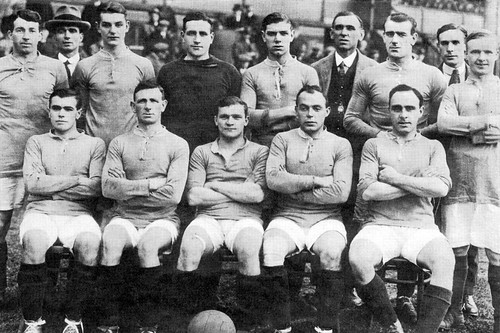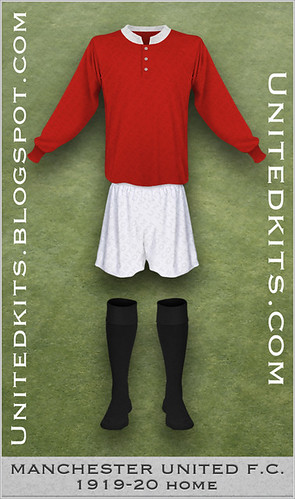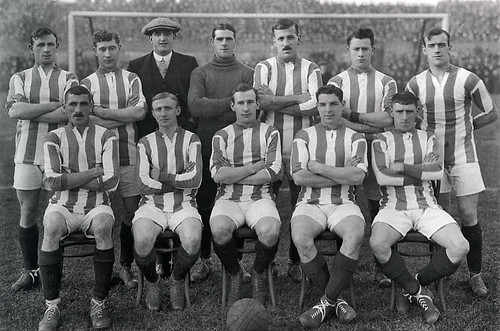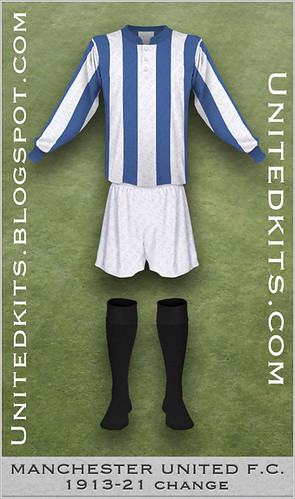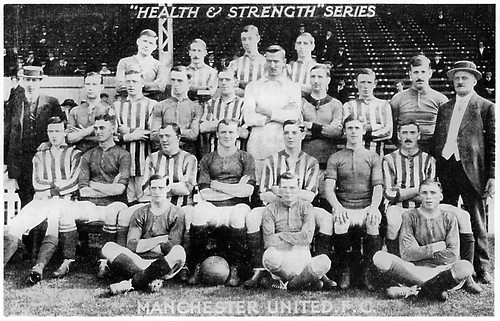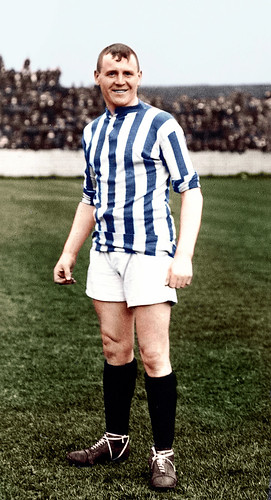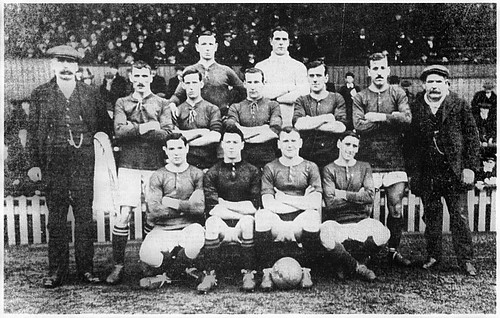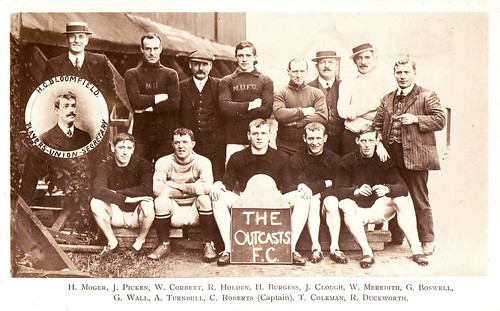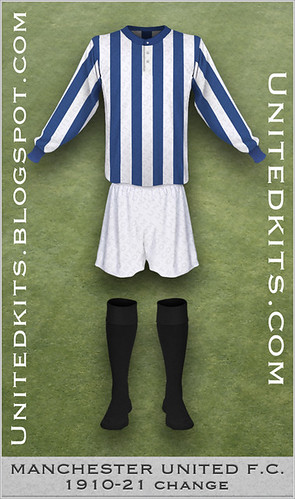A brief update to let readers know that several new photographs of badges from match-worn United shirts have been added to the Flickr set.
Monday 27 July 2009
Thursday 23 July 2009
1919-1922: The Return of Peace & the Resumption of League Football
On the August 30th, 1919, the league was resumed, just as it would have for the 1915/16 season, had it not been suspended due to the Great War.
The United team had seen many changes in that time, with the likes of George Wall leaving for Oldham, defensive duo Pat O'Connell and George Hunter also moving on and of course the loss of Sandy Turnbull who was killed in action. They also kicked off the new season without Billy Meredith who was apparently in a dispute with the club as he wanted to return to Manchester City but the club did not want to let him leave for free.
New players making their league debuts that season would include Joe Spence, Jack Silcock, Charlie Moore and Lal Hilditch, all of whom would be at the club until the early 1930s.
The United team line up before the home match against Aston Villa on December 6th 1919. They are wearing the same shirts seen in one of the 1911/12 team photographs, although they have clearly seen better days. Again, some have lost their buttons and been repaired by running laces through the holes. At this time, due to shortages caused by the war, teams had to appeal to supporters for donations of clothing vouchers or make do with whatever they could find, including damaged old kits like these:
The United team had seen many changes in that time, with the likes of George Wall leaving for Oldham, defensive duo Pat O'Connell and George Hunter also moving on and of course the loss of Sandy Turnbull who was killed in action. They also kicked off the new season without Billy Meredith who was apparently in a dispute with the club as he wanted to return to Manchester City but the club did not want to let him leave for free.
New players making their league debuts that season would include Joe Spence, Jack Silcock, Charlie Moore and Lal Hilditch, all of whom would be at the club until the early 1930s.
The United team line up before the home match against Aston Villa on December 6th 1919. They are wearing the same shirts seen in one of the 1911/12 team photographs, although they have clearly seen better days. Again, some have lost their buttons and been repaired by running laces through the holes. At this time, due to shortages caused by the war, teams had to appeal to supporters for donations of clothing vouchers or make do with whatever they could find, including damaged old kits like these:
Meredith returned to the side on boxing day and by May the team had secured a 12th place finish. Their FA Cup campaign ended in defeat to Villa in the second round.
The following season was much the same as the one that preceded it. United finished 13th in the league having exited the cup after a first round replay against Liverpool ended 2-1 to the Merseysiders.
The players pictured before two matches in the 1920/21 season. The socks do not appear as dark as on previous photographs. Instead, they appear to be the same shade as the shirts, so I will assume that this season the club wore red socks. This may have been the only colour available to the club at the time rather than by choice:
The following season was much the same as the one that preceded it. United finished 13th in the league having exited the cup after a first round replay against Liverpool ended 2-1 to the Merseysiders.
The players pictured before two matches in the 1920/21 season. The socks do not appear as dark as on previous photographs. Instead, they appear to be the same shade as the shirts, so I will assume that this season the club wore red socks. This may have been the only colour available to the club at the time rather than by choice:
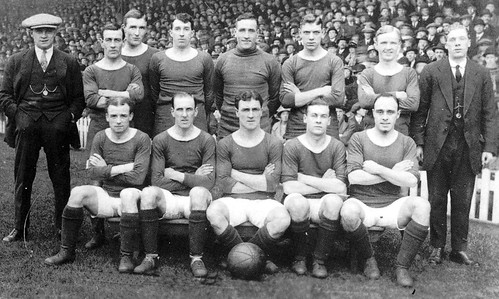
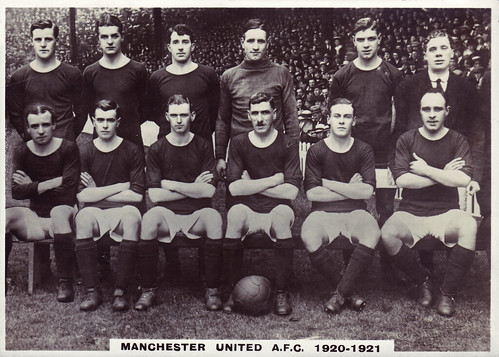
These photos are part of the extensive Leslie Millman collection that can be found at www.flickr.com/photos/manchesterunitedman1/ and are used with full permission.
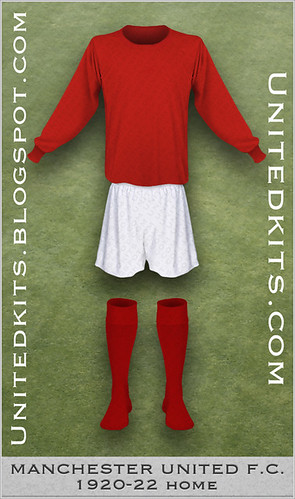
Billy Meredith finally left the club in the summer of 1921 to rejoin City. He had made a total 335 appearances for the Reds and by the time of his last game at United he was 46 years old. Despite his age he was still one of United's best players and was certainly missed the following season. Remarkably, he would continue to play professionally for a further three seasons.
United suffered from very poor form at the start of the 1921/22 season. They lost 5-0 to Everton on the opening day and by the end of October they had only won three matches out of twelve played. Manager Jack Robson had been suffering with health problems and was replaced in November by John Chapman, previously manager of Airdrieonians. He was not able to change United's fortunes quickly enough however, and that season ended with the club at the very bottom of the table. Jack Robson sadly died of pneumonia on the 11th of January 1922.
The team photographed at Old Trafford before a practice match ahead of the 1921/22 season. They appear to be wearing the same home kits as in the previous season except now with black socks with white hoops on the turnovers. The change kits are the same as those worn in the 1913/14 photograph, with more laces added to replace the missing buttons:
United suffered from very poor form at the start of the 1921/22 season. They lost 5-0 to Everton on the opening day and by the end of October they had only won three matches out of twelve played. Manager Jack Robson had been suffering with health problems and was replaced in November by John Chapman, previously manager of Airdrieonians. He was not able to change United's fortunes quickly enough however, and that season ended with the club at the very bottom of the table. Jack Robson sadly died of pneumonia on the 11th of January 1922.
The team photographed at Old Trafford before a practice match ahead of the 1921/22 season. They appear to be wearing the same home kits as in the previous season except now with black socks with white hoops on the turnovers. The change kits are the same as those worn in the 1913/14 photograph, with more laces added to replace the missing buttons:
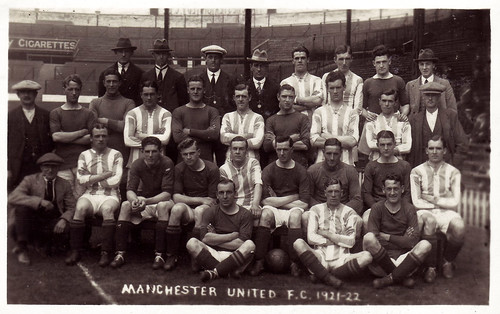
This photo is part of the extensive Leslie Millman collection that can be found at www.flickr.com/photos/manchesterunitedman1/ and is used with full permission


Another photograph from September 1921 shows the players wearing what appear to be plain black socks:
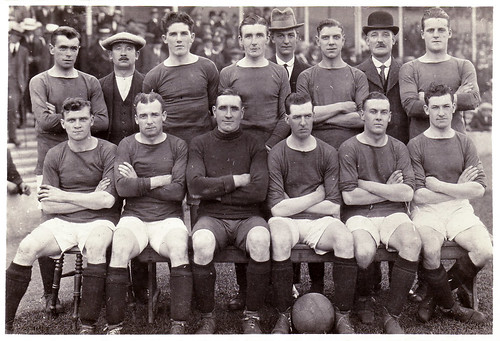
This photo is part of the extensive Leslie Millman collection that can be found at www.flickr.com/photos/manchesterunitedman1/ and is used with full permission
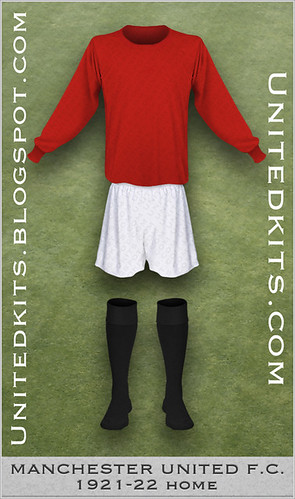
Tuesday 14 July 2009
1913-1919: The Outbreak of War
During JJ Bentley's time at the FA, he had clashed with the United players over their stance with the Players Union. Although he had previously supported the abolition of the maximum wage, he was quoted as saying the following in 1909: "The very suggestion of a strike of footballers shows the meanness of the motives behind it and in my judgement cannot be too strongly condemned".
Perhaps this was one of the reasons that club captain (and leader of the 1909 protest) Charlie Roberts was sold in the summer of 1913 to Oldham Athletic for a (record at the time) fee of £1,500. Also sold was his defensive partner Alex Bell, who went to Blackburn for £1,000. In turn, these are probably reasons why the 1913/14 season saw United finish in their lowest league position since their promotion in 1906 and exit the cup in the first round. Oldham, led by Roberts on the other hand finished in second place - to date, their best ever league position - while Bell's new club would win the title the season after that.
Perhaps this was one of the reasons that club captain (and leader of the 1909 protest) Charlie Roberts was sold in the summer of 1913 to Oldham Athletic for a (record at the time) fee of £1,500. Also sold was his defensive partner Alex Bell, who went to Blackburn for £1,000. In turn, these are probably reasons why the 1913/14 season saw United finish in their lowest league position since their promotion in 1906 and exit the cup in the first round. Oldham, led by Roberts on the other hand finished in second place - to date, their best ever league position - while Bell's new club would win the title the season after that.
The 1913/14 United team, pictured before a practice match, in various jerseys they had also worn in previous seasons:
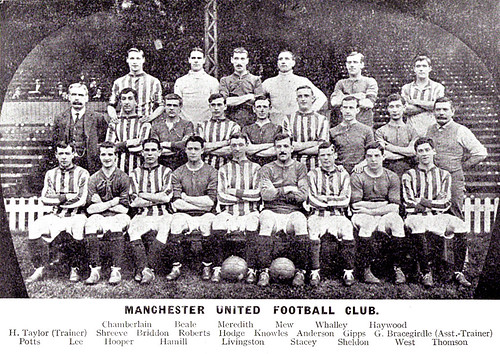
This is an edited version of an image from the extensive Leslie Millman collection, which can be found at www.flickr.com/photos/manchesterunitedman1/

This is an edited version of an image from the extensive Leslie Millman collection, which can be found at www.flickr.com/photos/manchesterunitedman1/
Another photo from that season shows them in home shirts with white collars. These jerseys are similar to those worn in the 1911/12 team photograph, but have a button on the white part, much like a traditional "grandad collar":
A third photograph dating from November 1913 shows the players in change jerseys with thicker stripes than had been previously worn. These would be used until the early 1920s:
Despite the outbreak of the First World War in June 1914, the 1914/15 football season went ahead as usual. United had attempted to make up for the loss of their key defenders by signing Chelsea's George Hunter towards the end of the previous season for £1,300 and Patrick O'Connell during the summer for £1,000. These were large fees for the time, but Hunter would not complete a full season for the club, while O'Connell became the club's new captain.
The 1914/15 team before a practice match. The thin striped change shirts are used once more:

This is an edited version of an image from the extensive Leslie Millman collection, which can be found at www.flickr.com/photos/manchesterunitedman1/ and is used with full permission.

This is an edited version of an image from the extensive Leslie Millman collection, which can be found at www.flickr.com/photos/manchesterunitedman1/ and is used with full permission.
Just after Christmas of 1914, Bentley, who was in ill health, was replaced by John "Jack" Robson, previously in charge of Brighton & Hove Albion. He would be the first at United to take the title of "Manager" rather than "secretary", and stayed with the club until 1921.
This change of leadership did not greatly help United (who up until that point had only won three games that season), as they continued to struggle and indeed were fighting to save themselves from relegation. In the end they were saved by just one point, but there would be more controversy, as several players found themselves embroiled in a match-fixing scandal.
The game against Liverpool on April 2nd, which United won 2-0 was under scrutiny after Liverpool's lackadaisical approach had seen them concede easily and miss a penalty. Weeks later, a £50 reward was being offered by a bookmakers for information that could help prove the match had been fixed. They had an unusual number of big-money bets had been placed on United to win the fixture 2-0. The odds were 7-1 and when the press heard of it there was a scandal brewing.
The Football League launched an investigation in May which went on until they released their findings the following December. They had uncovered damning evidence that there had indeed been a conspiracy to fix the game. Although the clubs as a whole were judged to have been unaware of the plot, the Football League found that three United players, four Liverpool players and a Chester FC player were at the centre of it. They were banned from football for life.
The United players involved were Sandy Turnbull, Arthur Whalley and Enoch West (the only one of them to have actually played in the game). The Liverpool players included Jackie Sheldon, who had been at United from 1909-13, and who acted as the go-between. West would never admit guilt in the case and even took the Football League to court for libel over their ruling. As a result of this, when the other players were pardoned after the war (which finally brought about a suspension of the league that summer), West was not. His ban was eventually lifted in 1945 when he was 59 years old. Whalley played again for United after the war, but tragically Turnbull, United's FA Cup hero, was a casualty of war - killed fighting in Arras, France, in 1917.
A rare photograph of a United team during the war. This was taken in 1916 and features George Wall, who did not go to fight in the war and an 18 year old Jack Silcock (top, second from right), a defender who would go on to represent England internationally:
This change of leadership did not greatly help United (who up until that point had only won three games that season), as they continued to struggle and indeed were fighting to save themselves from relegation. In the end they were saved by just one point, but there would be more controversy, as several players found themselves embroiled in a match-fixing scandal.
The game against Liverpool on April 2nd, which United won 2-0 was under scrutiny after Liverpool's lackadaisical approach had seen them concede easily and miss a penalty. Weeks later, a £50 reward was being offered by a bookmakers for information that could help prove the match had been fixed. They had an unusual number of big-money bets had been placed on United to win the fixture 2-0. The odds were 7-1 and when the press heard of it there was a scandal brewing.
The Football League launched an investigation in May which went on until they released their findings the following December. They had uncovered damning evidence that there had indeed been a conspiracy to fix the game. Although the clubs as a whole were judged to have been unaware of the plot, the Football League found that three United players, four Liverpool players and a Chester FC player were at the centre of it. They were banned from football for life.
The United players involved were Sandy Turnbull, Arthur Whalley and Enoch West (the only one of them to have actually played in the game). The Liverpool players included Jackie Sheldon, who had been at United from 1909-13, and who acted as the go-between. West would never admit guilt in the case and even took the Football League to court for libel over their ruling. As a result of this, when the other players were pardoned after the war (which finally brought about a suspension of the league that summer), West was not. His ban was eventually lifted in 1945 when he was 59 years old. Whalley played again for United after the war, but tragically Turnbull, United's FA Cup hero, was a casualty of war - killed fighting in Arras, France, in 1917.
A rare photograph of a United team during the war. This was taken in 1916 and features George Wall, who did not go to fight in the war and an 18 year old Jack Silcock (top, second from right), a defender who would go on to represent England internationally:

This is an edited version of an image from the extensive Leslie Millman collection, which can be found at www.flickr.com/photos/manchesterunitedman1/ and is used with full permission.
The jerseys the players are wearing in the above photograph are very much like some of those those worn from 1911-14, albeit with the addition of white trim behind the buttons:
Thursday 9 July 2009
1911-1913: The End of an Era
Following United's second Championship winning season and in those preceding the suspension of the league following the outbreak of the Great War, the club's fortunes took a downward turn. Players and managers left and financial difficulties came back to haunt them - mainly caused by the expense of the new stadium at Old Trafford and the loss of spectators as football fans went off to fight in Europe.
The team are photographed at Old Trafford with the league championship trophy ahead of the 1911/12 season in new jerseys with a white collar:
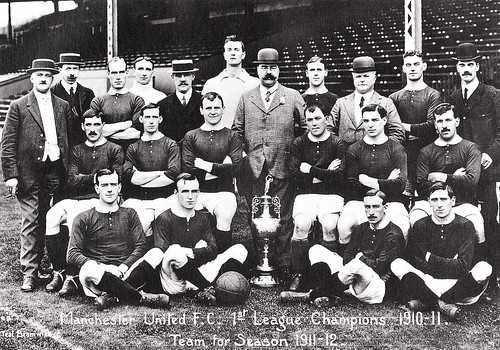
A close-up of Dick Duckworth and a portrait of Billy Meredith in the new jersey:
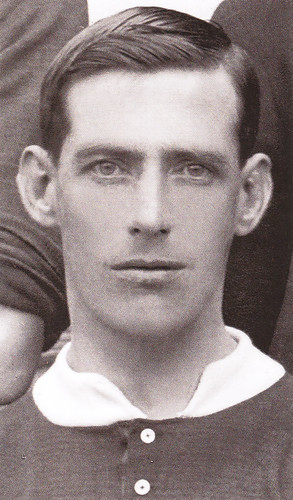
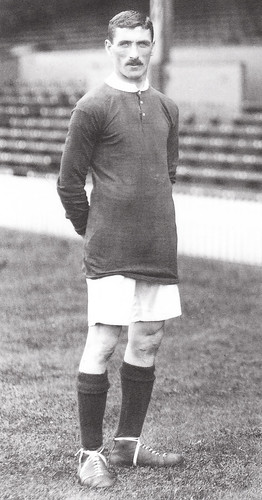
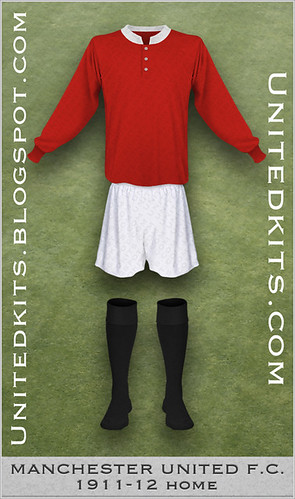

A close-up of Dick Duckworth and a portrait of Billy Meredith in the new jersey:



Another photo from 1911/12 shows the players in a variety of different jerseys, including the home and change kits from the previous seasons and a red shirt like above but with a red collar - a style of jersey would be worn until at least 1914:
In the 1911/12 season the highlight was the 8-4 Charity Shield win over Charlton Athletic, with Harold Halse scoring a hattrick in each half. Unfortunately, they could only manage a 13th place finish in the league and were knocked out of the cup in the 4th round (equivalent to the modern day quarter-final stage) by Blackburn Rovers.
In the summer of 1912, the team who had been so successful over the past few years began to break up. Striker Halse and giant 'keeper Moger left the club. Most surprisingly of all was the departure of Mangnall who went to the other side of town to manage Manchester City. Although in his time there he would only take the blues to second place in the league before he left in 1924 (shortly after that club's move from Hyde Road in Ardwick to Maine Road in Moss Side), there would not be anyone as successful in his position at United until Matt Busby.
Some players were brought in - most notably Jack Mew, who was brought in to replace Moger and would spend 13 years at United and T. J. Wallworth was installed as acting secretary until a permanent replacement for Mangnall was found in John J Bentley - former president of the club and of the Football League - who he was instrumental in founding - and vice-president of the FA.
Some players were brought in - most notably Jack Mew, who was brought in to replace Moger and would spend 13 years at United and T. J. Wallworth was installed as acting secretary until a permanent replacement for Mangnall was found in John J Bentley - former president of the club and of the Football League - who he was instrumental in founding - and vice-president of the FA.
Some players in the above photo seem to have lace-neck shirts, but this is most likely a quick repair done to replace lost buttons on the previous season's jerseys with the red collars. Other players have jerseys with no collar like those worn between 1903-11 but with three buttons instead of two. These jerseys would be worn (apparently concurrently with several other variations) until at least 1915:
United's league form improved in Bentley's first season as they finished in 4th place, although they had less success in the cup where they were knocked out in the third round by Oldham.
Wednesday 1 July 2009
1909-1911: From Outcasts, To Old Trafford & To The Championship Once More
United's FA Cup triumph was almost immediately followed by controversy. In the summer, the FA banned the entire team from taking part in the next season's competitions after they refused to abandon the Players Union - the founding of which they had been heavily involved in.
It had been at Harry Stafford's Imperial Hotel - a pub on Piccadilly of which he had been made manager by J H Davies - where Billy Meredith, Charlie Roberts and other players gathered for several meetings in 1907 that had led to the formation of the Union which the FA now perceived as a threat - so much so that they made all clubs write new contracts for their players that forbade them from becoming members. There was some resistance at first, but eventually all the league clubs buckled to their demands. All except for United. The FA did not humour their disobedience and took the measure of immediately banning all of the players from participating in the league and cup. They even closed the club's Bank Street ground to them, forcing the United players to practice over the other side of town at Fallowfield Stadium - a ground that had hosted the FA Cup Final in 1893 - and this was where the famous "Outcasts F.C." photograph was taken:
It had been at Harry Stafford's Imperial Hotel - a pub on Piccadilly of which he had been made manager by J H Davies - where Billy Meredith, Charlie Roberts and other players gathered for several meetings in 1907 that had led to the formation of the Union which the FA now perceived as a threat - so much so that they made all clubs write new contracts for their players that forbade them from becoming members. There was some resistance at first, but eventually all the league clubs buckled to their demands. All except for United. The FA did not humour their disobedience and took the measure of immediately banning all of the players from participating in the league and cup. They even closed the club's Bank Street ground to them, forcing the United players to practice over the other side of town at Fallowfield Stadium - a ground that had hosted the FA Cup Final in 1893 - and this was where the famous "Outcasts F.C." photograph was taken:
(This photo is part of the extensive Leslie Millman collection that can be found at www.flickr.com/photos/manchesterunitedman1/ and is used with full permission)
The players steadfast stance inspired other such as Everton's Tim Coleman (also on the above photograph) and eventually his teammates joined United in refusing to give up their Union. So did those from Middlesbrough, Newcastle, Sunderland and Liverpool - and from many other teams from across the country - until the FA was left with no choice but to back down and rescind the bans. The league was to go ahead after all, and with United as part of it as usual. For more information on this chapter of football history, see this article on the excellent Spartacus Educational site. Another article on that site reports that "When the Manchester United team played in the first match of the season on 1st September, 1909, they all wore AFPU arm-bands". Sadly I currently have no photographs from this match.
1909/10 was not to be an outstanding season for the Reds as the previous one had been - they finished 5th in the league and were knocked out of the cup in the first round by Burnley, whom United had beaten on the way to the previous season's final - but it was to be memorable as it marked the club's move to Old Trafford.
The move four miles west had been agreed back in 1908 and the plans were announced in March 1909, shortly before the club's appearance in the FA Cup Final. It was decided that Bank Street was not only unsuitable for use as a football ground with it's toxic fumes and waterlogged pitch, but that the team and their rising number of supporters had now outgrown it.
The famous architect of football grounds such as Ibrox to Goodison Park and White Hart Lane, Archibald Leitch, was hired to work on the new ground to be built on land owned by the chairman between the railway line and the canal on Warwick Road. It was originally designed to hold 100,000 spectators but was scaled back to 60,000 due to financial restraints.
Below is an artist's impression of the new United ground, complete with two covered stands - although only one would be covered when the ground opened (the current South Stand or Main Stand as it was known). The other stands also extend further back from the pitch than they did when the stadium was actually built:
1909/10 was not to be an outstanding season for the Reds as the previous one had been - they finished 5th in the league and were knocked out of the cup in the first round by Burnley, whom United had beaten on the way to the previous season's final - but it was to be memorable as it marked the club's move to Old Trafford.
The move four miles west had been agreed back in 1908 and the plans were announced in March 1909, shortly before the club's appearance in the FA Cup Final. It was decided that Bank Street was not only unsuitable for use as a football ground with it's toxic fumes and waterlogged pitch, but that the team and their rising number of supporters had now outgrown it.
The famous architect of football grounds such as Ibrox to Goodison Park and White Hart Lane, Archibald Leitch, was hired to work on the new ground to be built on land owned by the chairman between the railway line and the canal on Warwick Road. It was originally designed to hold 100,000 spectators but was scaled back to 60,000 due to financial restraints.
Below is an artist's impression of the new United ground, complete with two covered stands - although only one would be covered when the ground opened (the current South Stand or Main Stand as it was known). The other stands also extend further back from the pitch than they did when the stadium was actually built:
(This photo is part of the extensive Leslie Millman collection that can be found at www.flickr.com/photos/manchesterunitedman1/ and is used with full permission)
The last game at Bank Street was played on 22nd January against Spurs - a 5-0 victory. Only days later a storm blew one of the stands over causing extensive damage to the terraced houses opposite - United had chosen just the right time to leave Clayton.
The first game at Old Trafford took place on February 19th 1910, but was one to be forgotten - a 4-3 loss to Liverpool, with United squandering a 2-0 lead in front of over 50,000. Sandy Turnbull scored United's first ever goal at the ground. However, it was to be a rare home loss at that time, as United won all their remaining games at Old Trafford that season and all but one in the next, when they were again crowned League Champions after the title race went to the wire. In the end, United pipped Aston Villa to the post by a single point.
The first game at Old Trafford took place on February 19th 1910, but was one to be forgotten - a 4-3 loss to Liverpool, with United squandering a 2-0 lead in front of over 50,000. Sandy Turnbull scored United's first ever goal at the ground. However, it was to be a rare home loss at that time, as United won all their remaining games at Old Trafford that season and all but one in the next, when they were again crowned League Champions after the title race went to the wire. In the end, United pipped Aston Villa to the post by a single point.
The team before a practice match at the start of the 1910/11 season:
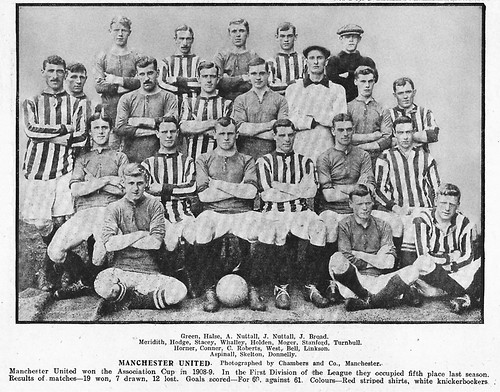
(This photo is part of the extensive Leslie Millman collection that can be found at www.flickr.com/photos/manchesterunitedman1/ and is used with full permission)

(This photo is part of the extensive Leslie Millman collection that can be found at www.flickr.com/photos/manchesterunitedman1/ and is used with full permission)
The text states United's colours as "red stripes", but this appears to be one of a number of inaccuracies in the text - several player's names are spelled incorrectly for example. It is fairly unlikely that any team would wear red as a home kit and red and white stripes as a change kit as they would clash, meaning another kit would have to be kept as third choice which was very uncommon at the time. Instead, it is far more likely to have been blue and white stripes like previous United change kits:
Subscribe to:
Posts (Atom)











